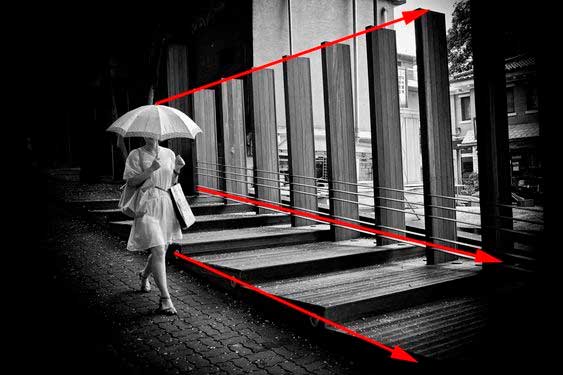Photography is frequently referred to as the art of visual storytelling. Leading lines are a powerful storytelling device that photographers often use.
These lines serve as tools to guide the viewer's eye across the image, adding depth, movement, and narrative. They are more than just compositional elements.
This guide will cover the technique of using leading lines in your images, from spotting them in your surroundings to applying them effectively to enhance your visual narrative.
Understanding Leading Lines

Everywhere you look, from urban environments to natural landscapes, leading lines are present. The challenge is honing your eye's spotting ability.
Here are some common types of leading lines
- Natural Lines: These are found in nature in the form of winding rivers, rows of trees, or rocky shorelines. They naturally draw attention throughout their course.
- Architectural Lines: In cities and other built environments, structures like highways, bridges, and buildings often provide distinct lines that can be used effectively in compositions.
- Man-Made Lines: Ordinary items such as railings, fences, and even a row of parked bicycles can serve as leading lines in your photographs.
- Implied Leading Lines: Sometimes, leading lines can be suggested by the arrangement of elements, even if they aren't physically present. For instance, having several people looking in the same direction can create an implied line.
Using Leading Lines in Composition

Once you've identified leading lines in your scene, the next step is to incorporate them into your composition.
Here's how
- Placement and Aim: Position your camera so that the leading lines run diagonally across the image or from the foreground to the background. The line's orientation can influence the mood and narrative of your photograph. While diagonal lines suggest movement and dynamism, horizontal lines often convey stability.
- Leading lines can be used to frame your subject or the main focus of your image, heightening its impact. This lends more context and depth to your photo.
- Depth and Perspective: Leading lines introduce a sense of depth, making your image appear three-dimensional. Harness this effect by placing your subject where the lines converge, creating a strong focal point.
- Balance and Symmetry: Play with the balance of your composition. If you have dominant leading lines on one side of the frame, think about counterbalancing them with a contrasting element on the opposite side.
Storytelling and Emotional Expression
Beyond being compositional tools, leading lines are vital for narrating a story and eliciting emotion in your photographs.
Here's how
- Leading into the Unknown: Leading lines that disappear into the distance or around a bend create a sense of mystery and anticipation. This can engage viewers and spark curiosity about what lies beyond.
- Diagonal leading lines, especially if they appear to converge, can give a sense of dynamic movement. They are perfect for images aiming to convey excitement or motion.
- Horizontal leading lines, reminiscent of peaceful horizons or calm rivers, can evoke feelings of peace and tranquility. They are suitable for capturing serene settings or contemplative moments.
- Urban Tales: In cityscapes, leading lines formed by streets, alleys, or architectural details can tell stories of bustling urban life, solitude, or the passage of time.
Trying New Things and Being Creative

While mastering the fundamentals of leading lines is crucial, don't hesitate to innovate and stretch your creative boundaries.
- Not all leading lines have to be straight; they can also be curved. Curved lines can lend your composition a touch of elegance and charm. Think of meandering rivers, winding roads, or bridge arches.
- Try working with diverging lines that move apart, as opposed to leading lines that converge at a single point. This might lend your image a unique sense of separation or expansion.
- Leading lines don't necessarily need to be solid structures; they can exhibit texture and patterns. Effective leading lines can be created using patterns like rows of crops, cobblestone streets, or even footprints in the sand.
- Combining Elements: Framing, symmetry, and the rule of thirds are just a few compositional elements that can harmoniously coexist with leading lines. Merging these elements can result in images with profound depth and impact.
The Language of Leading Lines
Mastering the use of leading lines in photography is akin to speaking a visual language. It allows you to adeptly convey emotions, stories, and perspectives.
By identifying leading lines in your environment, understanding their compositional value, and experimenting with different kinds and forms, you elevate your photography.
In the end, leading lines are more than mere compositional tools; they are narrative strands that intertwine emotions and beckon viewers to engage with, explore, and experience the world through your lens.As you embark on your photographic journey, keep an eye out for the lines that guide you deeper into the captivating world of visual storytelling.